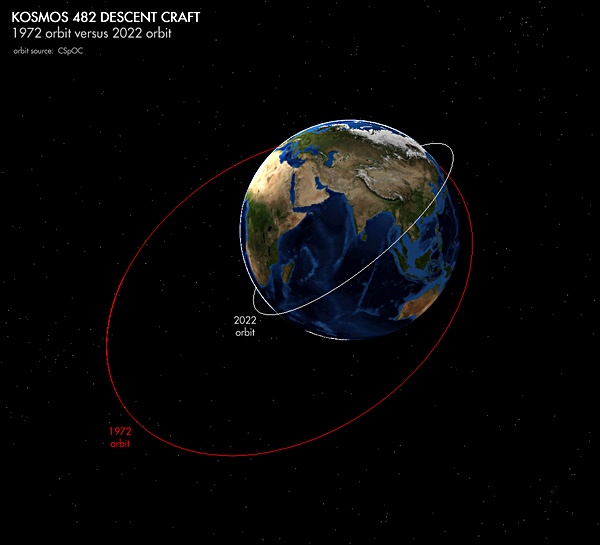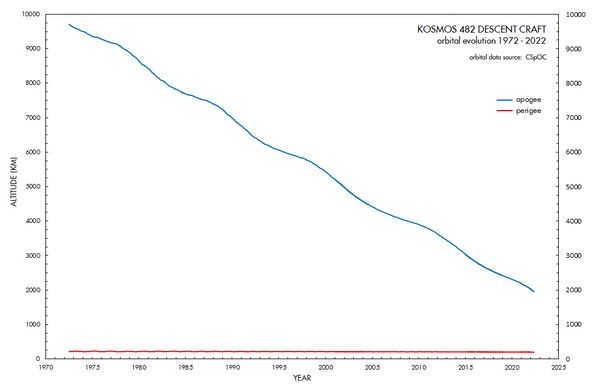Kosmos 482: questions around a failed Venera lander from 1972 still orbiting Earth (but not for long)
by Marco Langbroek
Monday, May 16, 2022
Fifty years ago, on March 31, 1972, just days after the launch of Venera 8, the Soviet Union made an attempt to launch yet another Venera probe. While it was meant to fly to Venus, something went wrong and it got stuck in Earth orbit instead. It subsequently was post-designated Kosmos 482 by the Soviets. Half a century later, one object associated to this launch is still on orbit, but it won’t be for long anymore. This object is 1972-023E, the Kosmos 482 Descent Craft, ostensibly the landing module of the Venera in its approximately one-meter protective shell.
| Half a century later, one object associated to this launch is still on orbit, but it won’t be for long anymore. |
The identity and real size of this object have recently been put to discussion, with some arguing it is not just the lander but includes a substantially larger part of the original Venera bus. I will present evidence, both observational and modelled, that this object is in fact the landing module only, not a substantially larger part of Venera hardware. I model it to reenter some three to four years from now, around 2025–2026. Being designed to pass through the atmosphere of Venus, it will likely survive its reentry into the Earth’s atmosphere.
An interplanetary launch that failed
Kosmos 482 launched from Baikonur only four days after the Venus probe Venera 8 was launched, and was likely of the same design. Unlike its successful sister ship, Kosmos 482 got stuck in a 206 x 9802 kilometer, 52-degree inclined highly elliptical orbit around the Earth. The upper stage of the Molniya 8K78M that should have propelled it into a heliocentric orbit to Venus shut down prematurely, apparently because of a wrongly set timer.
Initially, western military space tracking networks catalogued four objects connected to this launch. In addition to the Venera payload itself, these objects ostensibly were the Molniya Block L upper stage in a 206 x 9770 kilometer, 52-degree highly elliptical orbit; the Molniya second stage in a 206 x 326 kilometer, 51-degree low Earth orbit; and the Ullage platform in a 206 x 223 kilometer, 51.7-degree inclined low Earth orbit.
Table 1: objects related to the Kosmos 482 launch
| NORAD | COSPAR | DESIGNATION | REENTRY | INITIAL ORBIT |
|---|---|---|---|---|
| 6073 | 1972-023E | COSMOS 482 DESCENT CRAFT | 2025 - 2026 a | 210 x 9710 km |
| 5919 | 1972-023A | COSMOS 482 b | 05-05-1981 | 206 x 9802 km |
| 5923 | 1972-023D | SL-6 r/b (2) c | 20-02-1983 | 206 x 9770 km |
| 5920 | 1972-023B | SL-6 r/b (1) d | 01-04-1972 | 206 x 326 km |
| 5921 | 1972-023C | SL-6 PLAT e | 02-04-1972 | 206 x 223 km |
a: prognosis based on GMAT modelling by author
b: Venera main bus
c: upper (3rd) stage NVL Block L
d: 2nd stage Block I
e: Ullage platform
Payload separation into two objects
Sometime after the launch, the payload (1972-023A) separated into two objects. One of these kept the designation 1972-023A and was believed to be the Venera main bus. The second one got the designation 1972-023E (catalogue no. 6073) and is believed to be the Descent Craft, i.e. the actual landing module meant to be landed on Venus.
My analysis of the orbital elements of these two objects suggests that the separation happened in mid-June 1972, some 80–85 days after the launch. There is some evidence of a small discontinuity in the semi-major axis evolution of the 1972-023A object around June 21 of 1972, and a conjunction analysis suggests that the two objects were close near that same date. The separation was not necessarily the result of an explosion or otherwise violent breakup. After all, the main bus and descent craft are meant to separate at some point. From the difference in orbital altitude between both objects, I calculate the delta V involved in the separation to be around 8.5 meters per second. I have not been able to find information on the typical delta V with which a Venera lander is ejected from the main bus.
The ostensible main bus, 1972-023A, reentered on May 5, 1981, nine years after launch. The other object, the descent craft, 1972-023E, is the only object from this launch still in orbit today, and the main object of this study.
Orbital evolution
When the “Descent Craft” was first catalogued in July 1972, it was in a 210 x 9710 kilometer, 52.1 degree inclined orbit. Over the past 50 years the apogee altitude of this object has come down by more than 7,700 kilometers, and as of May 1, 2022, the object is in a 198 x 1957 kilometer orbit.
The image below shows the difference between the mid-1972 and mid-2022 orbits. The diagram shows the evolution of the apogee and perigee altitudes over 1972–2022.
 Venera 8 orbit of 1972 versus its orbit of 2022. |
 Evolution of the orbit over the period 1972–2022. |
Contention: is the “descent craft” only the descent craft?
Whether the Kosmos 482 “descent craft” is truly only the descend craft, i.e. the lander module contained in its approximately one-meter-diameter protective semi-spherical cover (see the image at the top of the article), has recently become a point of contention. In early 2019, a news item appeared on Space.com titled “Failed 1970s Venus Probe Could Crash to Earth This Year”. It was subsequently picked up by a number of news outlets, such as Newsweek and NBC News.
In these news items, two claims were made, both as it turns out unsubstantiated:
(1) that the object could reenter as early as that same year (2019);
(2) that the object is not just the lander module, but that it includes a substantial part of the Venera bus.
| The claim of “strong brightness variations” is something that is not borne out by my own observations on this object. |
Regarding the first claim about an “imminent” reentry of this object, both Jonathan McDowell in a solicited comment in the Space.com article, and myself in a solicited comment for Universe Today, pointed out that the orbital decay history of object 1972-023E was inconsistent with a reentry later that year and instead pointed to a reentry still several years in the future.
The two arguments given for the second claim, the claim that the object is not just the lander but includes a (considerable) part of the Venera bus, are:
(a) a reportedly “strong brightness variation” of the object;
(b) apparent detail and an “elongated shape” as seen on telescopic images of the object made by Dutch astrophotographer Ralf Vandebergh.
Brightness behavior
The claim of “strong brightness variations” is something that is not borne out by my own observations on this object. I have filmed it several times and never noticed a strong brightness variation. On the contrary, it is very stable in brightness.
No comments:
Post a Comment